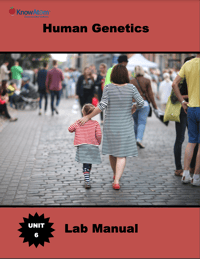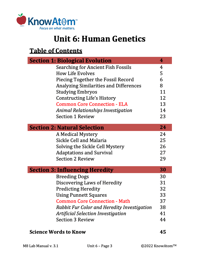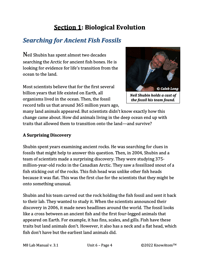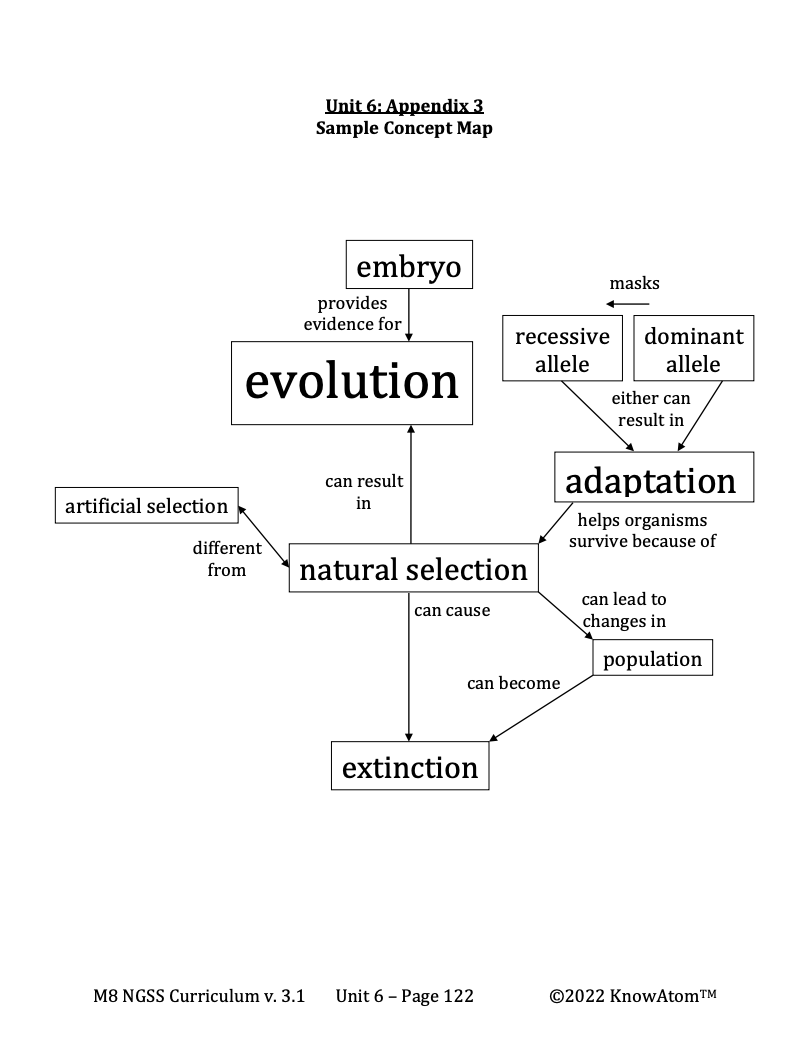In this lesson, students investigate the phenomena of natural selection and how it is one way that evolution occurs. They extend this focus by exploring how the ability of an organism to survive changes when its environment changes.
In this unit, students explore genetics, heredity, and evolution. For this lesson, students create an experiment to figure out the interconnectedness of the phenomenon of natural selection determining which organisms are most likely to survive and pass on their traits. This page showcases parts of key components of the lesson.
The science background section gives teachers more detailed information on the phenomena students explore. Below is an excerpt from this section on natural selection.
One of the primary drivers of evolution is natural selection, which is the theory that organisms well fitted to their environments will have offspring and pass on useful adaptations to future generations, while those with harmful traits will die off. An adaptation is a trait that helps an organism survive in its environment.
Natural selection depends on both genetic variability and the specific environment of a particular population. Genetic variability happens for several reasons. Mutations (permanent changes to an organism’s DNA) are one cause when they are hereditary, meaning they are passed down from parents to offspring.
Sexual reproduction is another cause of genetic variability because it creates offspring with the combined genetic information of a male and a female. The combination of genes ensures that each offspring is genetically different from their parents and from other offspring.
When there is genetic variability, some individuals will have a greater chance of surviving than other individuals. This is true for several reasons. For example, some adaptations might make it easier for certain individuals to escape from predators, such as by being faster than other individuals or being better able to blend into the environment. Other adaptations might make it easier for an individual to access food, or to find a mate for reproduction. When those adaptations allow an organism to survive and reproduce, the organism can pass those advantageous traits on. Over time, a new species may develop with those traits.
For example, the katydid is an insect that evolved with adaptations that help it blend in with its environment by looking like a leaf. It’s important to note that the mutations that led the katydid to resemble a leaf did not happen because they are beneficial to the insect. Instead, the mutations that led to those traits happened randomly, through mistakes in DNA replication or environmental influences. In the right environment, they offered an advantage.
Natural selection occurs because in every environment, there are limited resources of food, water, oxygen, and shelter. Because of this, there is competition among organisms for those resources. This competition limits the growth of populations. Those organisms that are best adapted to the environment are the ones most likely to survive, reproduce, and pass those desirable variations on to the next generation.
Because organisms interact with and depend on their environment, a change in the environment can alter which organisms thrive and which die off. There are many ways the environment can change. It can change gradually, over many years. For example, the temperature can increase or decrease, causing species that depend on a very specific temperature range to struggle.
Scientists can read the fossil record to find evidence of a major environmental change that led to massive extinctions. Extinction occurs when there are no longer any living members of a species in existence. For example, the wooly mammoth is an animal that was well adapted to the cold of the Ice Age. As temperatures warmed and early humans began hunting, however, the mammoth could not adapt and became extinct.
Humans can influence the environment as well. For example, in the 1950s, coal smoke had coated the normally light- colored bark of England’s trees with dark soot. As a result, light peppered moths, which had once blended into the trees, stood out starkly against the coal-coated bark. This made them easier prey for animals that eat moths. A dark form of peppered moths, which had once been rare, became common because they could blend, avoiding predation.
In this lesson, students investigate the phenomena of natural selection and how it is one way that evolution occurs. They extend this focus by exploring how the ability of an organism to survive changes when its environment changes.

Prepared hands-on materials, full year grade-specific curriculum, and personalized live professional development designed to support mastery of current state science standards.
Misconception: The goal of natural selection is to produce better-suited organisms—in other words that it “helps” organisms survive.
Fact: Natural selection is a goal-less process that occurs because of genetic variation and heredity.
Adaptation : a trait that helps an organism survive in its environment
Dominant allele : an allele (version of a gene) that shows its effect even if the organism just has one copy of it
Natural selection : the theory that organisms well fitted to their environments will have offspring and pass on useful adaptations
Recessive allele : an allele (version of a gene) that only shows its effect if the organism has two copies of it

A Medical Mystery
In the late 1940s, a scientist named Tony Allison traveled with a group of other scientists to Kenya, a country in Africa. As they traveled around, Tony took blood samples of people from the different tribes who lived in the area.
Allison noticed something surprising in the blood samples. He observed that the sickle cell trait was much more common in certain populations of people than in other populations. Remember that sickle cell disease is caused by a mutation of one of the genes that codes for hemoglobin. This mutation causes some blood cells to become sticky, rigid, and shaped like crescent moons, rather than flexible and doughnut-shaped.
Scientists were puzzled because sickle cell disease is such a deadly disease. It generally kills its victims young, before they can reproduce and pass along the mutated gene to offspring. This should have resulted in the mutation for sickle cell disease dying out because it wasn’t getting passed on to future generations.
Adaptations and Survival
This has to do with the theory of natural selection. Natural selection states that organisms well fitted to their environments will have offspring and pass on useful adaptations, while those with harmful traits will die off. An adaptation is a trait that helps an organism survive in its environment. In other words, those traits that are beneficial are most likely to get passed along to future generations, increasing in frequency in the population. In contrast, harmful traits are likely to decline in frequency because organisms with harmful traits are less likely to survive and reproduce. Over time, this can lead to the development of new species.
Sickle Cell and Malaria
Allison’s data showed that there were far more people who had sickle cell anemia on the coast and near lakes. He realized that the sickle cell gene was present in hot, humid areas. These areas were also prime breeding grounds for insects carrying malaria. Malaria is a potentially deadly disease that kills more than a million people every year. It does this by invading red blood cells.
A Recessive Trait
Allison knew that sickle-cell disease was recessive. This means that in order to have the disease, a person must inherit the mutated sickle cell gene from both of their parents. Remember that individuals carry two alleles for each trait, one from each parent. Alleles are forms of the same gene that have small differences in the sequence of DNA bases. These alleles can be dominant or recessive. A dominant allele shows its effect even if the organism just has one copy of it.
For example, the allele for brown eyes is dominant. A person just needs to inherit one allele for brown eyes from one of their parents to have brown eyes. In contrast, recessive alleles only show their effect if the organism has two copies of it. You would need to inherit recessive alleles from both parents to have grey, green hazel, or blue eyes.
This is why a person has to inherit the sickle cell mutation from both parents in order to get the disease. Someone who has one sickle cell allele and one healthy allele is called a carrier, but they will not have the disease.


Solving the Sickle Cell Mystery
Allison wondered whether the sickle cell gene got passed on because those people with just one copy of the mutated gene had an advantage over people without any copies—they were protected from malaria.
Scientists now know that the sickle cell mutation produces an enzyme that protects against malaria. Anyone who inherits just one copy is protected against malaria and does not inherit the disease. Those people are more likely to survive and reproduce. Those people who inherit both copies have sickle cell anemia, which can be lethal. Those people who don’t inherit any copy of the mutated gene will not get sickle cell disease, but they will also not be protected against malaria.
The survival of the sickle cell gene is an example of evolution at work. In places where malaria is highly prevalent, those people who carry just one copy of the sickle cell gene have a strong evolutionary advantage. They aren’t affected by sickle cell anemia and they are protected from malaria.
This answered scientists’ question about why the sickle cell gene hasn’t died out. Having the mutation protects carriers of the gene in places where malaria is most common, helping them survive malaria.
In this lesson students develop an experiment to investigate how variations in traits in a population of organisms can increase some organisms’ probability of surviving and reproducing in a specific environment. Students collect and analyze data on organisms that survive in both light and dark environments, looking for patterns that might suggest a relationship between the color of the organism and its ability to survive when its environment changes. This experiment helps students figure out how natural selection phenomena depends on genetic diversity and can cause populations of organisms to change over multiple generations, which is one way that the phenomena of evolution occurs.
KnowAtom incorporates formative and summative assessments designed to make students thinking visible for deeper student-centered learning.

Standards citation: NGSS Lead States. 2013. Next Generation Science Standards: For States, By States. Washington, DC: The National Academies Press. Neither WestEd nor the lead states and partners that developed the Next Generation Science Standards were involved in the production of this product, and do not endorse it.